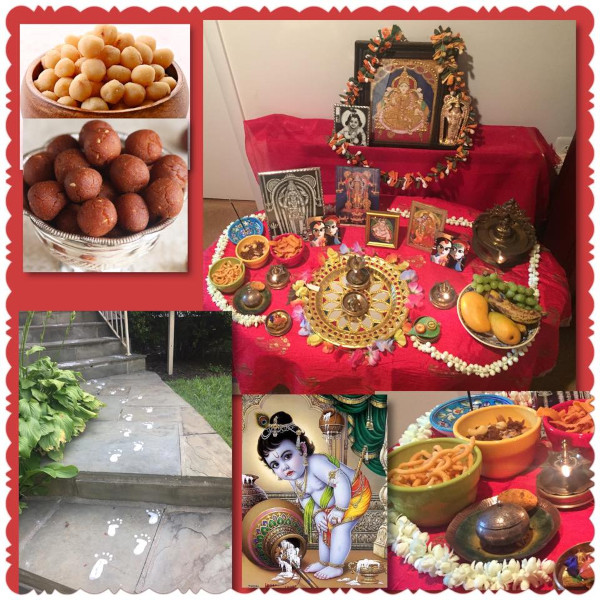Latest Contributions
Janmasthami – Holding on to tradition amid a pandemic

Meera Balasubramanian was born and brought up in Madras, Tamil Nadu. She graduated from Stella Maris College with a BA in Sociology, and got her MBA from the Asian Institute of Management, Manila. She has enjoyed living in Manila, Istanbul and Hong Kong. Currently, Meera lives in a suburb of Washington, D.C. with her husband.
August 11, 2020 marked Krishna Jayanthi or Janmashtami this year, the celebration of the birth of Krishna, the 8th child of Devaki and the 8th avatar of Vishnu. Whatsapp chats with sisters and nieces motivated me into surveying the contents of the box in the garage that had survived many moves to unearth pictures of Krishna for my make-shift altar.
I grudgingly began the laborious and time consuming task of making murukkus as a token offering. As I stared at the bubbling oil around the frying dough for what seemed like hours, scenes of my mother’s preparations for the festival played out on the screen of my mind very vividly.
Growing up in a large household, festivals were always a great production and lots of fun. I accompanied Amma to the market located in and around the famous Mylapore temple and its tank. The area would be dressed in festivities, colorful vegetables and fruits piled up attractively for the picking, vendors calling customers to their stalls, decorative flyers pasted in the walls, religious music blaring from random microphones. Festivals simply added gaiety to the already cheerful setting, infecting everyone with enthusiasm.
We always stopped at the Sri Vidya store for ritual supplies. Armed with flowers to decorate the puja room and hair, vethalapakupazham (betel leaf, betel nuts and bananas, seasonal fruits and coconuts for the offering and all sorts of vegetables for the meal,) we would return home to a frenzy of activity. Spurred on by the cacophonous exuberance of the market Amma would scurry back and forth from the kitchen to the puja room belting out orders to the deaf ears of her offspring.
Amma would clean the room, oil and wick the lamps and draw the kolam for Appa’s morning prayers. She would rise early, light the lamp, decorate the pictures with the strung kadambam (mix of white, orange and green flowers) and malli (jasmine), separating the sweet smelling pink and red roses onto the basket for the veneration.
Janmashtami is usually celebrated in the evening. After lunch, Amma would decorate the front steps and the entrance with a huge kolam made of ground rice flour, expertly drawn with a cloth dipped in the paste and two fingers moving in rapid coordination. She would make a smaller version in the puja room on which she would place the vilakku (silver lamp with oil and wick). We would help with making little baby footsteps from the same ground rice flour, mimicking those of the endearing baby Krishna.
Amma would put out the bakshanams of the festival - the murukkus, the salt and sweet cheedais, the jaggery sweetened poha (beaten rice) with coconut as offering. Krishna’s favorite ball of home churned white butter would take pride of place alongside the fried and sweet delicacies. Typically, these would be made the previous day in large quantities by Amma’s able assistants Ganga maami or Seetha maami. The lady would sit the gas stove on the floor of the kitchen and spend all day making the dough and frying different goodies. It was quite an operation that yielded several drums of edible deliciousness for the Raman family and for visitors.
Appa would light the pungent smelling camphor for the aarti and Amma would make the offering with prayers. We had several baby Krishnas in our family over the years and my parents fondly called all the children “Kanna” as a term of endearment.
In Washington D.C., I never really had the time or the inclination to indulge in celebrations that called for complicated cooking. Luckily for me, my friend and her mother-in-law always included me in their Krishna Jayanthi celebrations and I inevitably walked away with the joy of the festival and more importantly, the loot of goodies they packed for me.
With nostalgia tinged memories, I celebrate a birthday of the lovable baby whose antics are legendary, whose tales of mischief are oft repeated and enjoyed by little ones and adults alike.
This unfortunate year, thanks to the infectious enthusiasm of my youngest niece Shwetha, we all celebrated with our own versions of the festival. I marvel at the authenticity of Shwetha’s celebration, replete with all things traditional, a replica of my mother’s production leaving no stone unturned.

The significance of festivals for me is about carrying on traditions and their artistry and the coming together of families and friends for the occasion. While the latter was rendered impossible by the COVID-19 pandemic, I did make an attempt this year, to hold on to tradition.
Add new comment